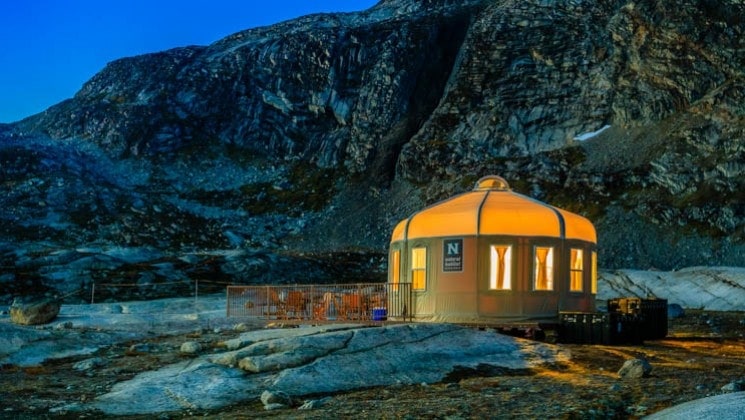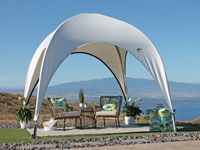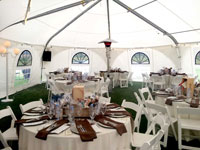One of the most iconic living quarters in the history of mankind, the yurt is most closely associated with the nomadic peoples of central Asia.
Herodotus, the father of history himself, was the first to describe yurts in the written word. According to him, yurts were the primary domiciles of the Scythians, who rode horses and lived in a nomadic fashion near the Black Sea from 600 B.C. to A.D. 300.
Traditional Nomadic Yurts: The Mongolian Ger
Nomadic Mongolian families called their homes “gers.” Their dwellings were made up of same-sized orange mesh-like walls that curved around the center of the tent. Each yurt had:
- Three to five walls and between 15 and 30 square meters of floor space
- Two posts erected at the center and held a circle of wood that provided a ridge around the top of the yurts
- Wooden slats formed the ceiling and connected to the central posts, which were intricately detailed and decorated

The material of each yurt could be updated or changed depending on the season or temperatures. A layer of felt was commonly used to increase insulation, and each family typically had several layers varying in thickness. When temperatures dropped or precipitation fell, the yurts would be covered with a layer of white cotton cloth that was sometimes decorated. This cloth would absorb moisture and keep the inhabitants dry.
Traditional Mongolian yurts always had:
- Wooden entrance doors that were highly decorated
- Wooden floors
- Carpets to keep the inhabitants warm and dry
- Wooden furniture
- A centralized stove
- A small cabinet with a sink to wash immediately upon entering the yurt.
These gers were easy to erect, light to carry, and wind-resistant, making them the perfect homes for traveling tribes who needed to move camp frequently.
Historians have recorded that in the 13th century, Genghis Khan led his entire Mongolian empire from a massive yurt that traveled on the back of over 20 oxen and was heavily guarded at all times.
Mongolian yurts are still in wide use, with three-quarters of the country’s population living in gers to this day. Large cities, such as the capital Ulaanbataar, have districts of yurts scattered throughout the city. The community around these yurt quarters is one of a shared mentality, as many of the structures do not connect with municipal water supplies. Bathhouses, saunas, and spas are very common in these sections of the city.
Yurts Move West
The modern term “yurt” means something much different than the ger of Central Asia.
Credited with the introduction and popularization of modern yurts in North America is the late William Coperthwaite, who adopted a David Thoreau-like philosophy with his off-the-grid lifestyle in yurt structures he built himself.
William Coperthwaite
Coperthwaite, who died in 2013, was inspired by a 1962 National Geographic article about Supreme Court Justice William O. Douglas’s trip to Mongolia and the indigenous ger.
In-kind, Coperthwaite developed his own yurts through handmade construction methods and tools. Instead of felt and canvas, Coperthwaite used locally milled wood to side his yurts.
Coperthwaite continued to experiment with slightly tweaked yurt structures on his property until a community formed around them, which later became known as the “Yurt Foundation.” The foundation became a nonprofit and continues to promote research and education surrounding yurt living. More than anyone, Coperthwaite is credited with popularizing the yurt building style in the United States and the rest of North America.
Chuck and Laurel Cox
One of Coperthwaite’s students, Chuck Cox, was among the first to iterate on his teacher’s ger-inspired yurt designs.
While at Cornell University, Chuck and his wife Laurel built a canvas-covered version of Coperthwaite’s yurt and ran tensioned-steel aircraft cables along the top of the wall to keep the fabric’s shape and appearance, in a set of plans called “The Portable Yurt.”
These plans included the Mongolian-style straight roof rafters as well as an offset octagonal design topped with a Plexiglass skylight.
The Coxes’ yurt design, paired with attention brought to yurts by the Yurt Foundation, created a boom in the ‘60s and ‘70s. Companies still use the basic design outlined in “The Portable Yurt” today.
Kirk Bachman
Kirk Bachman was among the students who used Chuck and Laurel Cox’s portable yurt plans.
He built a portable yurt for his senior project and moved with it to the backcountry of Idaho to become a nature guide.
Bachman inspired a backcountry yurt movement after his employer asked him to build more and more yurts on his property. He tweaked the original plans for “The Portable Yurt” to make his yurts more resistant to snow and extreme weather, and eventually started his own company.
Glamping and the Modern Interest in Yurts

No other hobby has pushed yurts further into the mainstream vocabulary than glamping.
The socially agreed upon term for glamorous camping is sweeping the luxury resort and vacation world, with sleepy dude ranches and ski resorts suddenly becoming high-end destinations for vacationers.
While the experience of glamping is a far cry from the rugged pup tent of old, it can offer a comfortable, modern retreat after long days in the wilderness or on horseback.
Most glamping yurts are equipped with modern bedding, seating, and other amenities to provide at-home comfort while enjoying the great outdoors.
Modern Fabric Yurts From WeatherPort

Today, the aesthetic appeal of yurts is coming back into fashion, potentially replacing the North American log cabin as the first choice for new constructions for camping, resorts, ski lodges, and guest ranches.
WeatherPort®, a brand from Alaska Structures, is meeting this new demand with luxury and modern yurts that combine the traditional style of the Mongolian ger with our mission to provide top-of-the-line comfort and durability to all.
Founded in 1968 by Clayton “Sweede” Hansen, WeatherPort has grown to serve over 65 countries by providing custom-built, portable fabric structures for any environment.
WeatherPort yurts incorporate:
- High-end fabric materials
- Aluminum or galvanized steel frames
- Lightweight, portable capabilities
- Latest engineering principles and manufacturing methods and can be built to local and international building codes
- Ability to withstand extreme weather and snow loads
WeatherPort® is a brand of high-quality fabric buildings from Alaska Structures®. Interested in learning more about our yurts? Contact us today!

















































































Leave a Reply